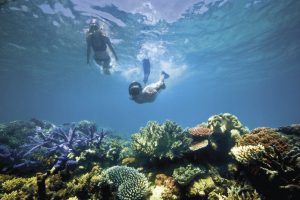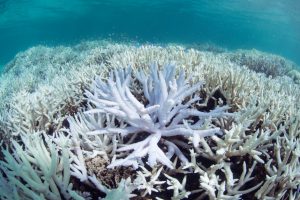From Sunday night Attenborough documentaries, to gap year photos from people you haven’t seen for years, we’re becoming increasingly informed about the world around us, enticing us to explore.
The Great Barrier Reef stretching the Queensland coastline is such a vast natural spectacle it can be seen from space. This complex ecosystem is home to over 450 types of coral and provides a habitat for marine creatures ranging from tropical fish to turtles (1), making it a popular holiday destination but for how much longer?

This beautiful system is under threat from rising sea temperatures, putting stress upon the corals causing them to release the algae from their tissues leaving only ghostly white calcium skeletons remaining. Both the coral and the algae rely on their partnership for energy and safety.
These ‘bleached’ corals are unsustainable and will perish within weeks if the sea temperature fails to return to within tolerable ranges. Due to the certainty of rising ocean temperatures, restoration success is unlikely and the devastation likely to continue. (1)
Once a year the reef engages in mass reproduction, triggered by temperature and the lunar cycle, this supports continued reef biodiversity as well as providing an ample source of food for reef dwellers. A shift in the temperature cues for reproduction will have severe impacts on community biodiversity as compared to natural incidents global shifts cause a greater long term impact, reducing the possibility of recovery (3).

Environmental change that impacts the structure of the corals will also affect their functional ability within the community. (5) Corals provide shelter for many marine species, allow for protected migration and increased genetic flow through coral corridors. This change alter the community structure and exasperate the global mass extinction we are currently experiencing.
So what is actually happening?
Global activities are impacting the future of this system dramatically, through climate change and our ever-increasing carbon footprint.
Corals extract calcium carbonate (the substance that forms eggshells) from the surrounding sea water to build the reef, using energy utilized from the algae within their structures. Each species builds differently to give beautifully diverse reefs, supporting creatures from zooplankton to green turtles.
Increasing atmospheric CO2, is absorbed by the oceans where its combined with seawater to produce an acid, leading to ocean acidification. This reduces the concentration of carbonate ions available for use by the corals to build their structures. (6)
These global changes aren’t the only driver of community shifts. On a local scale, flooding in Queensland has caused sediment and pesticide run off into the oceans. This increased nutrient input is devastating to a system reliant on diversity (7,8), where some species are more susceptible to change than others, causing a decline in both population density and biodiversity.
So our holiday snaps might never look the same again… To mitigate this change we need to alter our way of life, just travelling to see them impacts their survival! But keep snapping and keep people talking, its the only way we are going to make change!
| Flight # | Details: | Tonnes CO2 | ||
| 1 | Return | From London Gatwick to Darwin Australia | 1 passenger | 5.8 |
[500 Words]
References
- Australia’s Coral Reefs under Threat from Climate Change by Lesley Hughes, Will Steffen and Martin Rice (Climate Council of Australia).
- Great Barrier Reef | Australia’s Great Natural Wonder”. Great Barrier Reef. (2017). 21 Mar. 2017.
- Nyström, M., Folke, C., & Moberg, F. (2000). Coral reef disturbance and resilience in a human-dominated environment.Trends in Ecology & Evolution, 15(10), 413-417.
- The Ocean Agency. 2016. THE 3RD GLOBAL CORAL BLEACHING EVENT – 2014/2017. Available at: http://www.globalcoralbleaching.org/#essential-facts. [Accessed 21 March 2017].
- Richmond, R. H. (1993). Coral reefs: present problems and future concerns resulting from anthropogenic disturbance.American Zoologist, 33(6), 524-536.
- Hoegh-Guldberg, O., Mumby, P. J., Hooten, A. J., Steneck, R. S., Greenfield, P., Gomez, E., & Knowlton, N. (2007). Coral reefs under rapid climate change and ocean acidification.science, 318(5857), 1737-1742.
- Mongin, M., Baird, M. E., Tilbrook, B., Matear, R. J., Lenton, A., Herzfeld, M., & Duarte, C. M. (2016). The exposure of the Great Barrier Reef to ocean acidification.Nature communications, 7.
- Dubinsky, Z. V. Y., & Stambler, N. (1996). Marine pollution and coral reefs.Global change biology, 2(6), 511-526.
Recent Comments